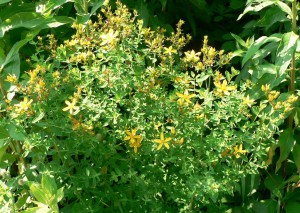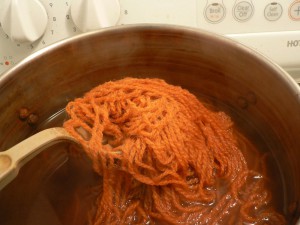This weekend, May 24th and 25th, is the 40th annual Massachusetts Sheep and Woolcraft Fair at the Cummington Fairgrounds. I am doing natural dyeing demonstrations again this year. I was there from 2-4 yesterday and will be there from 1-3 today. Yesterday’s weather was lovely for most of the day and I had a large crowd. Thanks to everyone who stopped by to watch and listen and ask questions! We had a brief heavy afternoon rainstorm but it cleared up after about half an hour. Today is supposed to be warmer with a slight chance of heavy rain and hail. Well, let’s hope for the best.
To prepare for the demo, on Friday night I made a dyebath with 12 ounces of dried whole tops of St.-John’s-wort from last fall. I cut the tops back after the flowers had gone by, and the dried stems and leaves had turned an amazing red color. I’ve used St.-John’s-wort flowers before, and the whole tops in bloom, but never just the dried tops alone. So, it is an experiment.
Here’s what St.-John’s-wort looks like in bloom.
Continue reading “Massachusetts Sheep and Woolcraft Fair 2014”


